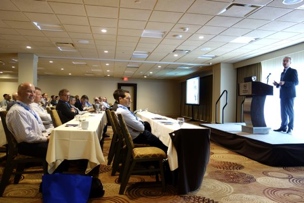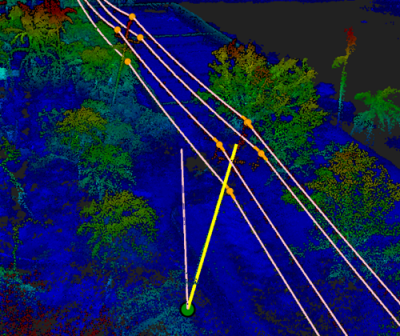In his talk welcoming attendees to the International LiDAR and Imaging Solutions Conference, Don Carswell introduced himself as the President of Teledyne Optech, “a job I’ve had for about 6 weeks now.” He noted that he’s still getting used to a new title and new company colors–where the conference colors used to be red, now they’re blue to represent Optech’s status as a full member of the Teledyne family. Beyond that, he assured all those present, not much with Optech has changed.
That being said, he dug into a history of Optech’s recent technology as told through the lens of Arthur C. Clarke’s three “laws.” The laws neatly and humorously dispel the idea of the impossible within technology, the most famous one stating that “any sufficiently advanced technology is indistinguishable from magic.” Carswell focused on a different law, though: “The only way of discovering the limits of the possible is to venture a little way past them into the impossible.”
“There are a lot of things we know for sure, or we think we know them,” Carswell said, before admitting to the crowd that something he had once “known” about LiDAR proved to be false. At an ASPRS presentation a number of years ago, he had stated definitively that “there’s no need for more than 4 LiDAR measurements per square meter,” because “it’s just plain impossible to do more.”
Looking at the history of Optech’s technological advances, his talk argued, it’s pretty obvious that he was wrong.
Carswell described why he had thought this was impossible. He started by explaining that for many years LiDAR devices fired only one laser at a time, a system which worked well enough “as long as the laser returns before the next one fires.” Once people started using airborne scanners, this caused problems with lasers returning while the LiDAR system was trying to fire another laser. The effect was a called a blind spot. Even if that problem were solved, Carswell said, there was still the problem of lasers bouncing off of dust and other particles in the atmosphere. “You become challenged in your ability to figure out whether you’re looking at an echo that came from a target you care about or whether you’re getting just some more dust from a laser shot.”
As long as you’re firing at a reasonable laser rate, these events are spread out and manageable, he said. Once you get to a laser rate up above a few hundred kilohertz, the useful returns and bad returns get closer and closer together–the problems get worse and so does your data. “It would be an impossible thing to filter out or deal with,” Carswell said. “And this is what led me to my incautious statement–needing more than 4 points per square meter means you need laser rates more than a couple hundred kilohertz, and well, that’s just impossible.”
Though the industry accepted this as an impossibility, Carswell explained that Optech’s customers kept asking for it anyway. Working to keep those customers happy, Optech looked at the problem again and developed their Pulsetrak technology to allow airborne scanning at a higher rate. Carswell noted that the demand from his employees and the imagination of his coworkers ultimately helps the company to “move the needle between the possible and impossible,” as Arthur C. Clarke noted.
He gave other examples where Optech’s customers had asked for something he thought was impossible, but that turned out to be very possible: finding a way for counties to afford a $3 million coastal zone mapper, finding a way to survey water depth, sending LiDAR units into space on a 14-year mission, and so on. He hopes there will be more firsts like this now that Optech has fully transitioned into Teledyne and has access to their California R&D facilities.
Carswell’s talk was carefully designed to position Optech as a company willing to try new, unlikely applications and technologies within the 3D-imaging space. It was never explicitly said, but it seems that Optech might even be willing to move into 3D-imaging applications that no one in the industry has approached yet.






